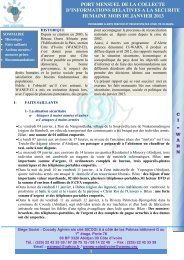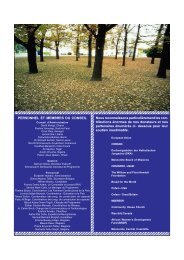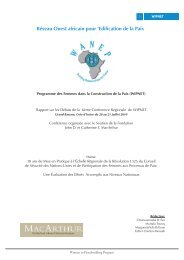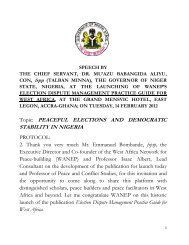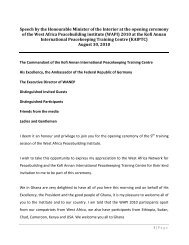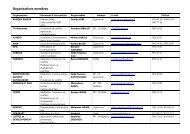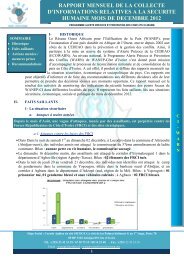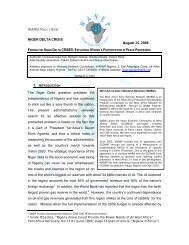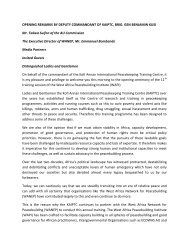DEVELOPMENT AND IMPLEMENTATION of National Action Plans ...
DEVELOPMENT AND IMPLEMENTATION of National Action Plans ...
DEVELOPMENT AND IMPLEMENTATION of National Action Plans ...
Create successful ePaper yourself
Turn your PDF publications into a flip-book with our unique Google optimized e-Paper software.
PrefaceOn October 31, 2000, Security Council Resolution 1325 was unanimously adoptedbased on the recognition <strong>of</strong> the disproportionate impact <strong>of</strong> conflicts on womenand girls and their various experiences in the area <strong>of</strong> peacebuilding. Since then fourother complementary resolutions have been adopted – UNSCR 1820, 1888, 1889 and 1960to address the gaps identified in UNSCR 1325. The core mandates <strong>of</strong> these resolutions arecondensed into 4 pillars (Ps) - participation <strong>of</strong> women in the peace processes, protection <strong>of</strong>women in war and peace, prevention <strong>of</strong> conflicts and prosecution <strong>of</strong> perpetrators <strong>of</strong> sexualand gender-based violence.The United Nations Security Council recognized that the national implementation <strong>of</strong> UNSCR1325 and related resolutions is an important mechanism for furthering the women, peaceand security agenda. Thus, the United Nations Security Council Presidential statements <strong>of</strong>2004/40 and 2005/52, called to member states to implement the resolution 1325 includingthe development <strong>of</strong> NAPs or other national level strategies such as peace policies, genderpolicies or medium/long term development plans and has consistently recommendedthat member states accelerate the development <strong>of</strong> both national and regional action plansfor the implementation <strong>of</strong> resolution 1325. The development <strong>of</strong> national action plans bymember states unfortunately has been very slow such that 12 years after the adoption<strong>of</strong> UNSCR 1325, only about 42 countries out <strong>of</strong> 192 countries have so far developed theirnational action plans. Lack <strong>of</strong> technical know-how, one <strong>of</strong> the reasons cited for this slowpace necessitated the development <strong>of</strong> this guideline.In writing this guideline, it is recognized that there is no one-size-fit all and as such thepurpose <strong>of</strong> the guideline is to provide a generic template – a simple step-by-step guide to theformulation and implementation <strong>of</strong> NAPs that can be used by all national governments andgovernment institutions, regional organizations, non-state actors and institutions interestedin the advancement <strong>of</strong> the women, peace and security agenda. It is also recognized thatthe context within countries differ and this will determine which <strong>of</strong> the pillars the NAP willfocus on.The Guideline is divided into five sections. Section 1 deals with the introduction whichprovides information on women, peace and security, UNSCR 1325 and related resolutions,importance <strong>of</strong> NAPs in the implementation <strong>of</strong> UNSCR 1325 and the purpose <strong>of</strong> the guideline.Section 2 focuses on the processes <strong>of</strong> developing the guideline including the inception,context/situational analysis, stakeholder mapping and their roles, establishment <strong>of</strong> acoordinating mechanism, enabling stakeholder participation, through defining content <strong>of</strong>NAPs, identifying opportunities for resources mobilization, drafting <strong>of</strong> the NAPs, validation,finalization and launching and dissemination <strong>of</strong> NAPs. This section also spells out the stepsinvolved in the formulation <strong>of</strong> NAPs. Section 3 focuses on the implementation arrangementswhile Section 4 was concerned with monitoring and evaluation – defining the terms; whoshould do the M & E and the reporting systems and feedback. The challenges associated1



![English [266KB] - West Africa Network for Peacebuilding](https://img.yumpu.com/50460007/1/184x260/english-266kb-west-africa-network-for-peacebuilding.jpg?quality=85)
